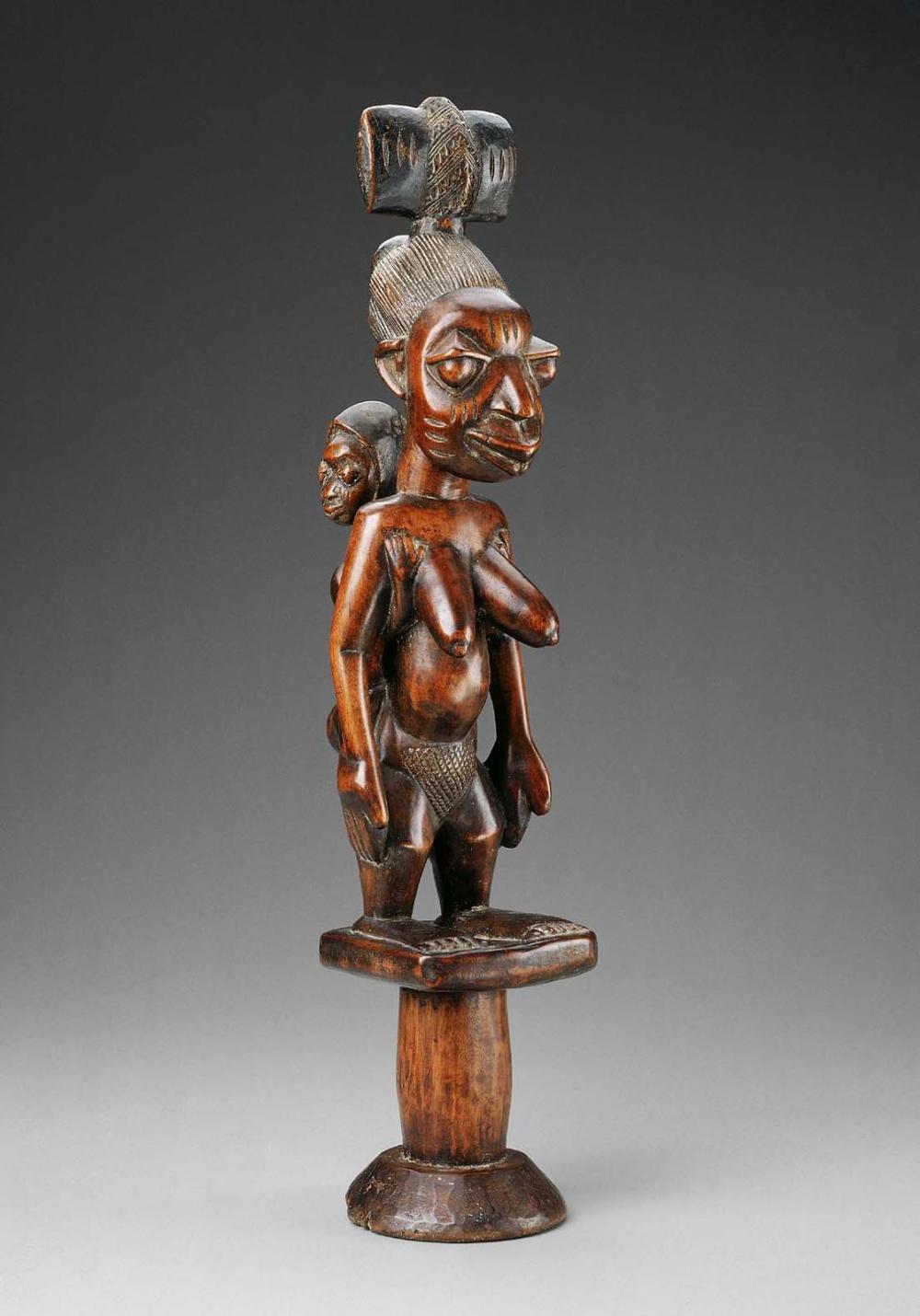Advanced Search 
Masterfully sculpted by an artist in the village of Ijomu in the Ora-Igbomina region, this dance staff is topped by a female figure whose perfectly smooth skin glows in the light, her diamond-shaped eyes half-opened. When not in active use, its fine details would have been visible on an altar to Sango, a deified former king of the Yoruba city of Oyo. In public, the staff would have been carried by a woman or man inducted into the priesthood of Sango. These priests invite Sango to possess them, making the deity accessible to the gathered worshippers. In this possession trance, the priests dance with a sculpture like this one held in their left hands, a signal that the occasion is outside of the realm of normal life, where one would use the right hand for most tasks.
A Sango priestess stands atop the staff, her knees flexed and body bent forward from the hips, ready to dance. The child strapped to her back turns its head to look to the right, its hands curled under the woman’s arms in a tender gesture. The baby refers to Sango’s power in granting children, as well as to the woman’s purity. Young Yoruba mothers remained celibate until their children had finished nursing, a state of purity that aided their spiritual life. Perched above the woman’s hair, a double axe, with an ornamental pattern on the wrapped portion in the center, creates a sort of crown. The axe is made of two stones called celts, thought by devotees to have been sent by Sango, who is associated with thunder and lightening, and collected in Sango’s shrines. The celts on this dance staff are the most important element of the staff from a spiritual perspective, while the fine sculpture of a mother in the center of the staff draws the eye.

Shango staff
Yoruba
early to mid-20th century
Object Place: Ijomu village, Nigeria, Ora-Igbomina region
Medium/Technique
Wood
Dimensions
54.61 cm (21 1/2 in.)
Credit Line
Gift of William E. and Bertha L. Teel
Accession Number1991.1070
CollectionsAfrica and Oceania
ClassificationsSculpture
Masterfully sculpted by an artist in the village of Ijomu in the Ora-Igbomina region, this dance staff is topped by a female figure whose perfectly smooth skin glows in the light, her diamond-shaped eyes half-opened. When not in active use, its fine details would have been visible on an altar to Sango, a deified former king of the Yoruba city of Oyo. In public, the staff would have been carried by a woman or man inducted into the priesthood of Sango. These priests invite Sango to possess them, making the deity accessible to the gathered worshippers. In this possession trance, the priests dance with a sculpture like this one held in their left hands, a signal that the occasion is outside of the realm of normal life, where one would use the right hand for most tasks.
A Sango priestess stands atop the staff, her knees flexed and body bent forward from the hips, ready to dance. The child strapped to her back turns its head to look to the right, its hands curled under the woman’s arms in a tender gesture. The baby refers to Sango’s power in granting children, as well as to the woman’s purity. Young Yoruba mothers remained celibate until their children had finished nursing, a state of purity that aided their spiritual life. Perched above the woman’s hair, a double axe, with an ornamental pattern on the wrapped portion in the center, creates a sort of crown. The axe is made of two stones called celts, thought by devotees to have been sent by Sango, who is associated with thunder and lightening, and collected in Sango’s shrines. The celts on this dance staff are the most important element of the staff from a spiritual perspective, while the fine sculpture of a mother in the center of the staff draws the eye.
ProvenanceSold by Peter Wengraf, Arcade Gallery, London, to Claude Bentley (b. 1915 - d. 1990), Highland Park, IL [see note]. February 10, 1979, sold by Pace Primitive and Ancient Art, New York, to William and Bertha Teel, Marblehead, MA; 1991, year-end gift of William and Bertha Teel to the MFA. (Accession Date: January 22, 1992)
NOTE: Yale Van Rijn Archive of African Art, no. 0043354.
NOTE: Yale Van Rijn Archive of African Art, no. 0043354.
